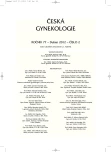Laparoscopically assisted neovagina formation – updated Vechieti surgery
Authors:
I. Rejdová 1; M. Petrenko 2; Z. Hodická 1
Authors‘ workplace:
Gynekologicko-porodnická klinika FN Brno a LF MU Brno, přednosta prof. MUDr. P. Ventruba, DrSc., MBA
1; I. gynekologicko-porodnická klinika LF UK a UNB Bratislava, přednosta prof. MUDr. M. Borovský, PhD.
2
Published in:
Ceska Gynekol 2012; 77(2): 104-108
Category:
Original Article
Overview
Aims of the work:
To evaluate the file o patients operated for the agenesis of uterus and vagina by laparoscopic assisted neoplastic of vagina according to Vecchietti.
Type of the study:
Original study.
Setting:
Gynecologic-Obstetrics Dpt, Medical Faculty of Masaryk University and University Hospital, Brno.
Materials and methods:
The study included 13 patients operated from September 2000 until April 2011. The patients were operated for the agenesis of the uterus and vagina by laparoscopic assisted neoplastic of vagina with gradual retraction of the special “olive” into the retrovesical space.
Results:
All of the operations were performed without any serious complication. The retraction of the olive was done once in 2 to 3 days. The dilatation period varied between 10 to 14 days. The length of the vagina, after removing the olive, was 8 to 10 cm. During examination, 2 to 4 months later, the length of the neovagina varied from 8 to 10 cm. During later follow-up controls, 11 patients reported regular sexual intercourse with which they were satisfied.
Conclusion:
This operation technique enables patients, with undeveloped vagina, satisfactory sexual life. Our results are comparable to the ones of the other authors.
Key words:
uterus agenesis, vaginal agenesis, vaginal neoplastic, laparoscopy.
Sources
1. Bartoš, P. Congenital vaginal aplasia: Laparoscopic reconstruction of neovagina using the Vecchietti technique in the Mauer-von Rokitansky- Kuester – Haeser syndrome. Čes Gynek, 2000, 65, s. 45–47.
2. Csermely, T., Halvax, L., Sárkány, A., et al. Sexual function after modified laparoscopic Vecchietti’s vaginoplasty Pediatr Adolesc Gynecol. 2011, 24(3), p. 147-152.
3. Edmonds, DA. Congenital malformations of the genital tract and their management. Best Pract Res Clin Obstet Gyn, 2003, 17, 1, p. 19–40.
4. Fedele, L., Bianchi, S., Frontino, G., et al. The laparoscopic Vecchietti’s modified technique in Rokitansky syndrome: anatomic, functional, and sexual long-term results. Am J Obstet Gynecol, 2008, 198(4), p. 377.e1-6.
5. Hořejší, J. Dětská gynekologie. Praha: Avicenum, 1999, s. 284.
6. Hořejší, J. Vrozené vývojové vady rodidel. Moderní Gynek Porod, Levret, 2001, 10, s. 431–436
7. Kaloo, P., Cooper, M. Laparoscopic-assisted Vecchietti procedure for creation of neovagina: an analysis of five case. Austr NZJ Obstet Gyn, 2002. 42(3), p. 307–310.
8. Oliveira, MA., Kano, AE., Melki, LA., et al. A simple and effective traction device for laparoscopic formation of a neovagina using the Vecchietti technique. J Minim Invasive Gynecol, 2008, 15(5), p. 611–614.
9. Rejdová, I., Petrenko, M., Zahrádková, M. LSK asistovaná neoplastika pochvy dle Vecchiettiho. Sborník abstrakt Česko - Slovenské konference reprodukční gynekologie, Brno, Medica publisching and consulting, 2002, s. 19–20.
10. Vacek, Z. Embryologie pro pediatry. Praha: Karolinum a JP, 1992, s. 210–211.
Labels
Paediatric gynaecology Gynaecology and obstetrics Reproduction medicineArticle was published in
Czech Gynaecology

2012 Issue 2
Most read in this issue
- Triple negative breast cancer – prognostically highly unfavourable group cancer of breast
- Possibilities of IVF in native cycle
- Urinary tract infections in pregnancy: when to treat, how to treat, and what to treat with
- Vaginal birth after previous caesarian section – outcomes analysis 2007–2010
